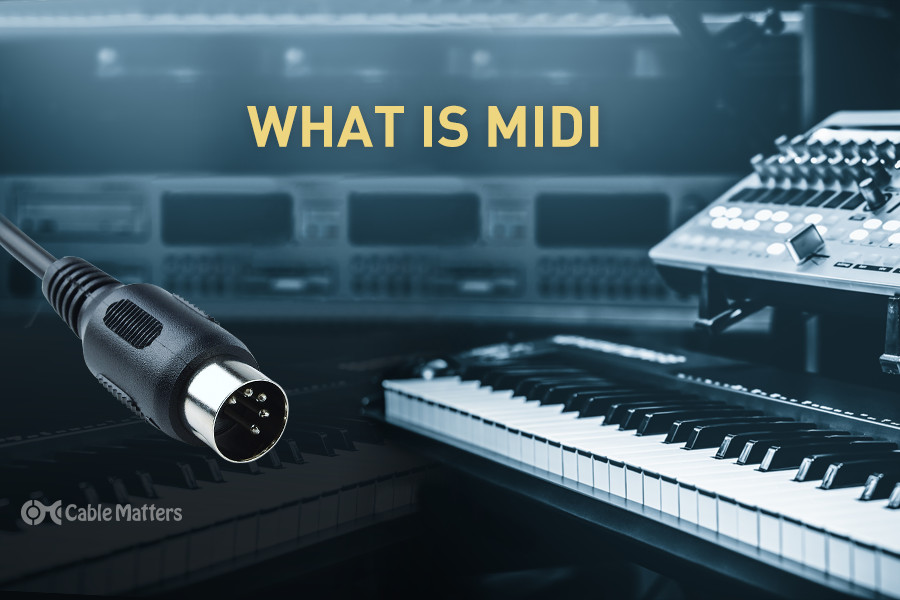
If you have a musical instrument with an MIDI port, you may be wondering what is MIDI? The Musical Instrument Digital Interface, or MIDI, is a technical standard that collects a number of technologies which together allow for a wide range of musical instruments, computers, and audio devices to connect to, and communicate with, one another.
MIDI – A brief history
The world of music is full of an extraordinary range of electronic instruments, synthesizers, production equipment, and in the more modern day, computers. Connecting them all together seemed like an impossible task, which is why MIDI was created in the early ‘80s, to simplify the process. Where before, instruments of different manufacturers could not be connected together, suddenly they could.
The standard is still going strong today. enabling modern musical instruments, equipment, and computers to connect to one another, but also connect to the expansive back catalog of MIDI-supporting instruments and equipment from the past.
What is MIDI and how does MIDI Work?
Like most digital connectors, there’s a MIDI port, and a MIDI cable. The former has five holes, which are plugged by the five pins on the latter’s header. Devices feature one or multiples of three MIDI port types: MIDI Out, MIDI In, and MIDI Thru. MIDI Out allows for information to be sent from the device, MIDI In can receive it, and MIDI Thru allows information to be transmitted through that device to another. In each instance, secondary cables are typically required to transmit information back and forth, rather than in just one direction.
When you want to extend a MIDI connection, you can use MIDI couplers, which let you plug two MIDI cables into them. Alternatively, you can use MIDI splitters and Y-Cables to transition from a male MIDI to a female, or vice versa.
For more complicated MIDI connections between multiple devices, you can use MIDI interfaces, which let you connect more MIDI-compatible devices together at a central location that help transmit all the information to the right instrument or device.
Modern devices will typically have both traditional MIDI and USB connections, both of which allow the same transmission or reception of MIDI messages. For devices without USB, you can use a USB to MIDI adapter. Some, like Cable Matters’ USB to MIDI cable, even support USB-C devices like tablets.

What is MIDI used for?
MIDI is used to send signals – called messages – between instruments, computers, controllers, and other MIDI devices. Those MIDI messages can be broken down into system messages and channel messages. System messages can be things like turning the device on or off, or changing the internal clock. Channel messages are more focused on sound, changing which notes are played, how long they’re player for, their pitch, tone, any pressured related information (such as a harder key press) that could affect the sound, or various other parameters of that particular device which alter the eventual sound it outputs.
Those messages ultimately decide how different devices interact with one another. For example, using a mixer to control the sound of a connected keyboard. In other cases, sound modules without their own specific interfaces, may require the connection of a MIDI controller to generate sound.
What is an MIDI sequencer?
When it comes to creating music using multiple MIDI-connected devices, MIDI sequences make the process far more simple. They store the MIDI data and manage its playback, recording and editing. Most modern Digital Audio Workstations (DAW) incorporate MIDI sequencers, and in many cases, started out as them before they became the more contemporary DAW interfaces of today.
Alternatively, it’s possible to use hardware sequencers connected to a DAW using a USB connection, which can give you access to a near-infinite array of digital instruments using VST Plugins. It’s also possible to use hardware sequencers exclusively, without a computer, to connect various MIDI-supporting devices and instruments together. They can then take the place of the DAW for editing and composing purposes.
MIDI Alternatives
Over the years, many alternatives to MIDI have been introduced, and though they haven’t received the general support among instruments and musical equipment as MIDI, they have proved successful in their own way. USB connections have become the most common electronic connector standard on the planet, and are almost always found on electronic musical equipment. They can be used in their more typical fashion for power delivery and data transfer, but also feature their own MIDI over USB protocol, enabling MIDI connections using USB. They are even inter-compatible with MIDI ports and cables, thanks to USB to MIDI adapters.
The now-mostly-defunct Firewire connection was introduced in the late-90s, as a digital MIDI alternative. Unlike USB, it allowed MIDI-compatible devices to communicate with each other without a computer.
What is MIDI 2.0?
MIDI 2.0 is a successor standard to MIDI that has been under development since 2005. It was officially presented in 2020. It’s not ready for general release yet, but introduces some exciting features which could drastically improve MIDI, whilst retaining many of its existing strengths, including increasing the number of supported MIDI channels, adding bidirectional communication, and incorporating MIDI 1.0 backward compatibility over MIDI cables and USB.